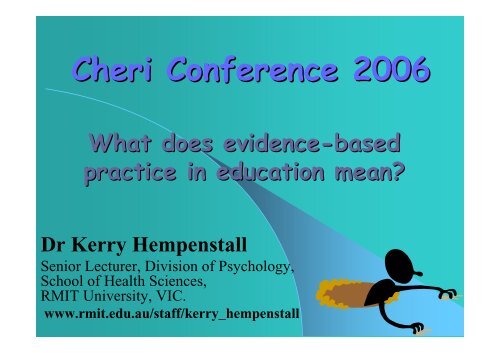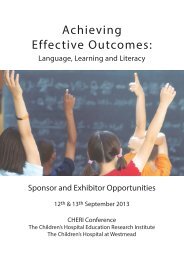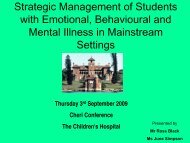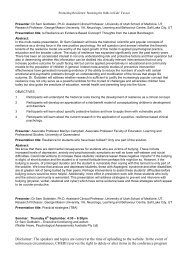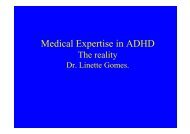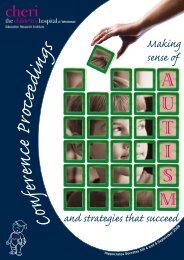What does evidence-based practice in education mean?
What does evidence-based practice in education mean?
What does evidence-based practice in education mean?
You also want an ePaper? Increase the reach of your titles
YUMPU automatically turns print PDFs into web optimized ePapers that Google loves.
Cheri Conference 2006<strong>What</strong> <strong>does</strong> <strong>evidence</strong>-<strong>based</strong><strong>practice</strong> <strong>in</strong> <strong>education</strong> <strong>mean</strong>?Dr Kerry HempenstallSenior Lecturer, Division of Psychology,School of Health Sciences,RMIT University, VIC.www.rmit.edu.au/staff/kerry_hempenstall
Evidence-<strong>based</strong> <strong>education</strong>(Teachers should) engage with the<strong>evidence</strong>-<strong>based</strong> research literature onwhat works for students, with and withoutlearn<strong>in</strong>g difficulties, and understand whatconstitutes <strong>evidence</strong> (National Inquiry <strong>in</strong>to theTeach<strong>in</strong>g of Literacy, 2005).
Why should <strong>education</strong> embraceresearch?Those fields that have displayedunprecedented development over the lastcentury, such as medic<strong>in</strong>e, technology,transportation, and agriculture have beenthose embrac<strong>in</strong>g research as the primedeterm<strong>in</strong>ant of <strong>practice</strong> (Shavelson & Towne,2002).
1990’s Evidence-<strong>based</strong> medic<strong>in</strong>eStep 1 - AttitudePractitioners learn of the effectiveness andrisks of different <strong>in</strong>terventions, us<strong>in</strong>greliable measures of benefit and harm as aguide to <strong>practice</strong>.There is strong support as it providesbetter health outcomes for patients.
Use external sourcesMedic<strong>in</strong>e has Medl<strong>in</strong>e(http://medl<strong>in</strong>e.cos.com) andCochrane Collaboration(www.cochrane.org)Useful when there is a consensus.
1990’s Evidence-<strong>based</strong> psychologyAmerican Psychological Association<strong>in</strong>troduced empirically supportedtreatment to highlight differentialpsychotherapy effectiveness.
1990’s Evidence-<strong>based</strong> psychologyThe criteria for a treatment to beconsidered well established <strong>in</strong>cluded•efficacy through two controlled cl<strong>in</strong>icaloutcomes studies or a large series ofcontrolled s<strong>in</strong>gle case design studies, and•availability of treatment manuals toensure treatment fidelity, and•provision of clearly specified clientcharacteristics.
So, what might it offer <strong>education</strong>?Reduce the pendulum sw<strong>in</strong>gs we’veendured, and redress <strong>education</strong>alachievement differences <strong>in</strong> ourcommunity (Slav<strong>in</strong>, 2002).
Evidence-<strong>based</strong> <strong>education</strong>Issues:•Acceptance of research as <strong>in</strong>form<strong>in</strong>gpolicy and <strong>practice</strong>•The role of teacher <strong>education</strong>•Discern<strong>in</strong>g sound from unsound research
Research can help with many questions•Are read<strong>in</strong>g approaches equally effective?•Is slow <strong>in</strong>itial progress cause for concern?•Can teach<strong>in</strong>g alter the trajectory ofdisadvantaged students?•Is social promotion or retention best?•Do smaller class sizes make a difference?
Evidence-<strong>based</strong> <strong>education</strong>:The <strong>in</strong>tegration of professional wisdomwith the best available empirical <strong>evidence</strong><strong>in</strong> mak<strong>in</strong>g decisions about how to deliver<strong>in</strong>struction (Whitehurst, 2002).Doesn’t supplant the craft of teach<strong>in</strong>g
Research <strong>in</strong>form<strong>in</strong>g <strong>practice</strong>?Resistance to us<strong>in</strong>g research as guide to<strong>practice</strong>• Uniqueness vs commonality• Teach<strong>in</strong>g has little effect on outcomes• Research is reductionist
Research <strong>in</strong>form<strong>in</strong>g <strong>practice</strong>?• Pressure for change is build<strong>in</strong>g with<strong>in</strong><strong>education</strong>.• Its purely artisan cloak challenged• Adopt the de<strong>mean</strong>our of a research<strong>based</strong>profession
Artisan cloak?When experience, personality, <strong>in</strong>tuition,or creativity are the sole determ<strong>in</strong>ants of<strong>practice</strong>, we risk <strong>in</strong>consistency at the<strong>in</strong>dividual level, and disaster at thesystem level.Consider Galileo: observation vs commonsense
Pressure for reformState and national test<strong>in</strong>g effects:•greater public awareness of studentprogress•government budgetary vigilance•<strong>in</strong>creased attention to the long-termeffects of curricula.
Litigation threat?A Melbourne parent successfully suedBrighton Grammar School for a breach ofthe Trade Practices Act (Aug, 2006).She argued that it had failed to deliver onits promise to address her son's read<strong>in</strong>gproblems.
Erroneous beliefs correctedLearn<strong>in</strong>g to read is as natural as learn<strong>in</strong>g tospeak (National Council of Teachers of English,1999).Parents read<strong>in</strong>g to children is sufficient toevoke read<strong>in</strong>g (Mem Fox, 2005)Good readers skim over words rather thanattend<strong>in</strong>g to detail (Goodman, 1985)
Skilled read<strong>in</strong>g <strong>in</strong>volves prediction fromcontext (Emmitt, 1996)English is too irregular for phonics to behelpful (Smith, 1999)Accuracy is not necessary for effectiveread<strong>in</strong>g (Goodman, 1974)
Fluent readers identify words asideograms (Smith, 1973).Children do not learn to read <strong>in</strong> order tobe able to read a book, they learn to readby read<strong>in</strong>g books (NZ M<strong>in</strong>istry of Educationdocument, 1988)Good spell<strong>in</strong>g derives simply from theact of writ<strong>in</strong>g (Goodman, 1989)
Parent <strong>in</strong>formation sheet:X Park Primary School 2003It is <strong>in</strong>appropriate for your child tobe directed to ‘sound-out’ words,us<strong>in</strong>g <strong>in</strong>dividual letter sounds, asmany words cannot be identified <strong>in</strong>this manner.
XXX PS Teach<strong>in</strong>g your childread<strong>in</strong>g strategies 2002If your child has difficulty with a word:•Ask your child to look for clues <strong>in</strong> thepictures•Ask your child to read on or reread thepassage and try to fit <strong>in</strong> a word that makessense.•Ask your child to look at the first letter tohelp guess what the word might be.
Problem Areas:Educational decision-makers havelacked a scientific framework, and been<strong>in</strong>cl<strong>in</strong>ed to accept proposals <strong>based</strong> ongood <strong>in</strong>tentions and unsupportedop<strong>in</strong>ions (Carn<strong>in</strong>e, 1991)
Problems are <strong>in</strong>ternationalU.S. Department of Education reportblamed the “disconnect between<strong>practice</strong> and <strong>evidence</strong>” for the lackof progress over the past 30 years <strong>in</strong>rais<strong>in</strong>g student achievement <strong>in</strong> math,read<strong>in</strong>g and science.
Problem AreasTeachers lack tra<strong>in</strong><strong>in</strong>g and direction <strong>in</strong>seek<strong>in</strong>g out and evaluat<strong>in</strong>g researchFewer than one <strong>in</strong> two hundred teachersare experienced users of the ERIC<strong>education</strong>al database.(Carn<strong>in</strong>e, 1995)
Problem AreasAustralian Research Council allocated$2.3 million last year on <strong>education</strong>projects, but policy makers and teachersgenerally take little notice(Professor Peter Cuttance, Centre for AppliedEducational Research, 2005).
Problem AreasThe f<strong>in</strong>d<strong>in</strong>gs of most research reportsrarely reach schools. "The treatment ofresearch by state <strong>education</strong>departments is <strong>based</strong> solely on costand what suits the political vision ofthe government of the day."(Ted Brierley, Australian Secondary Pr<strong>in</strong>cipalsAssociation president, 2005).
How might reform occur?Research-<strong>based</strong> <strong>education</strong>al <strong>practice</strong>s areeither mandated as <strong>in</strong> Great Brita<strong>in</strong>(Department for Education andEmployment, 1998) or a pre-requisite forfund<strong>in</strong>g as <strong>in</strong> the 2001 No Child LeftBeh<strong>in</strong>d Act (U.S. Department of Education,2002).
Teacher tra<strong>in</strong><strong>in</strong>g programsAll members of the teach<strong>in</strong>gprofession should have basicresearch skillsTeacher <strong>education</strong> programs havenot provided this tra<strong>in</strong><strong>in</strong>g. Why not?
Consume and/or conduct research?It is important that, at a m<strong>in</strong>imum,students <strong>in</strong> tra<strong>in</strong><strong>in</strong>g are tra<strong>in</strong>ed to becomegood consumers of research.In psychology, the pr<strong>in</strong>ciple of scientistpractitioneraccepted.
Need research methodstra<strong>in</strong><strong>in</strong>gWhen consensus is yet to be reachedpractitioners should be able to read thesigns
Tra<strong>in</strong><strong>in</strong>g <strong>in</strong> research designIn medic<strong>in</strong>e, psychology, and numerousother discipl<strong>in</strong>es, randomized controlledtrials (RCT) are considered the goldstandard for evaluat<strong>in</strong>g an <strong>in</strong>tervention’seffectiveness.In psychology, research methods are<strong>in</strong>cluded <strong>in</strong> every subject over the degree.
National Inquiry <strong>in</strong>to theTeach<strong>in</strong>g of Literacy (2005)Recommends a national program to:• produce <strong>evidence</strong>-<strong>based</strong> guides foreffective teach<strong>in</strong>g <strong>practice</strong> - thefirst to be on read<strong>in</strong>g;• promote research <strong>in</strong>to the mosteffective <strong>mean</strong>s of prepar<strong>in</strong>g preserviceteachers to teach read<strong>in</strong>g.
Teacher tra<strong>in</strong><strong>in</strong>g programsUnlike many other professions <strong>in</strong>Australia, there is no professional bodyaccredit<strong>in</strong>g teacher <strong>education</strong> at thenational level(Dr Gregor Ramsey, Chair, National AccreditationOf Pre-service Teacher Education, 2005)
National Institute for QualityTeach<strong>in</strong>g and School LeadershipObjective: A strengthened nationalresearch and <strong>evidence</strong> base to <strong>in</strong>formquality teach<strong>in</strong>g and school leadershipACER is evaluat<strong>in</strong>g current teacher<strong>education</strong> policies and <strong>practice</strong>s
Ask<strong>in</strong>g your own questions•WHO conducted this research?Authoritative, biased?•WHY was the research conducted? Arethe results self-serv<strong>in</strong>g? Is there<strong>in</strong>dependent corroboration?•WHAT is be<strong>in</strong>g researched? Does thedata support the conclusions
•WHERE was research done? Similarsett<strong>in</strong>g to yours?•WHEN was the research conducted?•ENOUGH participants for a crediblemeasure?•HOW was the data gathered andanalysed?
Stanovich and Stanovich (2003)1. F<strong>in</strong>d<strong>in</strong>gs published <strong>in</strong> refereed journals.2. F<strong>in</strong>d<strong>in</strong>gs replicated by <strong>in</strong>dependentresearchers with no stake <strong>in</strong> theoutcome.3. Consensus <strong>in</strong> research community aboutreliability and validity of the f<strong>in</strong>d<strong>in</strong>gs.
Stumbl<strong>in</strong>g block:Quality of much <strong>education</strong>al researchVary<strong>in</strong>g quality of past research producedequivocal or contradictory f<strong>in</strong>d<strong>in</strong>gs.Clearly a need for higher quality research
National Read<strong>in</strong>g Panel reviewPhonemic Awareness: 1962 studies, 52 metresearch methodology criteriaPhonics: 1,373 studies, 38 met criteriaFluency: 364 studies, 16 met criteriaVocabulary: 20,000 studies, 50 met criteriaComprehension: Of 453 studies, 205 metcriteria
Quality of <strong>education</strong>al researchJournal of Educational Research (2000-2003), only 6 out of 112 articles usedexperimental/control comparisons.
F<strong>in</strong>d<strong>in</strong>g good advice on program qualityPrestigious researchers peruse the <strong>evidence</strong>,they•Gather the methodologically soundresearch, and comb<strong>in</strong>e the results•Use statistical process, such as metaanalysis,to assemble the results fromthese studies.•Report f<strong>in</strong>d<strong>in</strong>gs widely.
Meta-analysesanalyses(Lloyd, Forness, & Kavale, 1999)Whole language180 studies 637 effect sizes Overall ES = .09Perceptual/motor tra<strong>in</strong><strong>in</strong>g180 studies 117 effect sizes Overall ES = .08Learn<strong>in</strong>g styles39 studies 205 effect sizes Overall ES = .14
Meta-analysesanalyses(Lloyd, Forness, & Kavale, 1999, 2005)Early <strong>in</strong>tervention programs74 studies 215 effect sizes Overall ES = .68Direct Instruction (DI)25 studies 100+ effect sizes Overall ES = .82Behavioural treatment of classroom problemsof students with behaviour disorder10 studies 26 effect sizes Overall ES = .93
Age of accountabilityThe fact that a program is <strong>based</strong> onscientific research <strong>does</strong> not <strong>mean</strong> that it iseffective.Programs that have strong, rigorous<strong>evidence</strong> of effectiveness should beemphasized over those that are only <strong>based</strong>on valid pr<strong>in</strong>ciples
Small scale studiesApart from the true experimental studiesthat enable cause to be assigned, wecont<strong>in</strong>ue to need the small scalecorrelational, descriptive, or ethnographicresearch.
Small scale studiesA s<strong>in</strong>gle study <strong>in</strong>volv<strong>in</strong>g a small numberof schools or classes may not beconclusive <strong>in</strong> itself, but many suchstudies, preferably done by manyresearchers <strong>in</strong> a variety of locations, canadd confidence that a program's effectsare valid (Slav<strong>in</strong>, 2003).
Where to f<strong>in</strong>d <strong>in</strong>formation about<strong>evidence</strong>-<strong>based</strong> <strong>in</strong>terventionswww.peri.org.au/<strong>What</strong> Works Clear<strong>in</strong>ghouse: U.S. Department ofEducation - trusted source of scientific <strong>evidence</strong> ofwhat works <strong>in</strong> <strong>education</strong>.Eric Digests Short reports (1,000 - 1,500 words) ontopics of prime current <strong>in</strong>terest <strong>in</strong> <strong>education</strong>Promis<strong>in</strong>g Practices Network: Programs forimprov<strong>in</strong>g outcomes for children, youth, andfamilies.
International Campbell Collaboration:Systematic reviews of <strong>evidence</strong> on theeffects of <strong>in</strong>terventions <strong>in</strong> the social,behavioral, and <strong>education</strong>al arenas.Social Programs That Work:Programs that are backed by rigorous<strong>evidence</strong> of effectiveness.Coalition for Evidence-Based Policy.Identify<strong>in</strong>g <strong>education</strong>al <strong>practice</strong>ssupported by rigorous <strong>evidence</strong>
Partnership for Read<strong>in</strong>g - a databasewith abstracts of approximately 460research studies related to the teach<strong>in</strong>gof read<strong>in</strong>g <strong>in</strong> grades K-3.
Comprehensive School Reform ProgramReport on scientifically <strong>based</strong> research onComprehensive School Reform.Bluepr<strong>in</strong>ts for Violence Prevention:Initiative for reduc<strong>in</strong>g adolescent violentcrime, aggression, del<strong>in</strong>quency, andsubstance abuse.Florida Center for Read<strong>in</strong>g Research:Information about research-<strong>based</strong><strong>practice</strong>s related to literacy <strong>in</strong>structionand assessment for children <strong>in</strong> P-12
American Institutes for Research (2005):Guide evaluat<strong>in</strong>g quality andeffectiveness of 22 primary schoolteach<strong>in</strong>g models.In a major meta-analysis of researchComprehensive School Reform andStudent Achievement, Direct Instructionwas given the highest classification(Center for Research on the Education of StudentsPlaced At Risk, 2002)
Council for Exceptional Childrenmakes judgments on professional<strong>practice</strong>s – See what the Alert series saysabout Phonological Awareness, SocialSkills Instruction, Class-wide PeerTutor<strong>in</strong>g, Read<strong>in</strong>g Recovery, MnemonicInstruction, Co-Teach<strong>in</strong>g, FormativeEvaluation, High-Stakes Assessment,Direct Instruction, Cooperative Learn<strong>in</strong>g.
www.peri.org.au/Oregon Read<strong>in</strong>g First Centerreviewed and rated 9 comprehensiveread<strong>in</strong>g programs. Programs had to<strong>in</strong>clude materials grades from P-3; andaddress the five essential componentsof read<strong>in</strong>g.http://www.rmit.edu.au/staff/kerry_hempenstall


